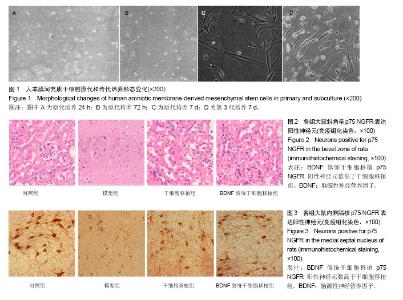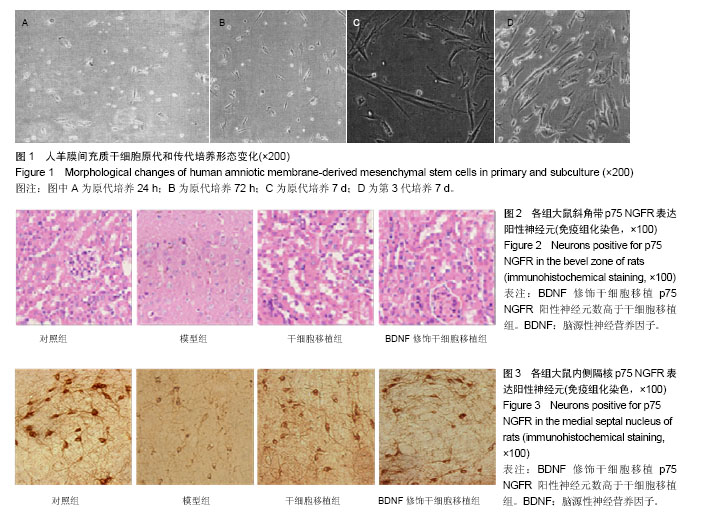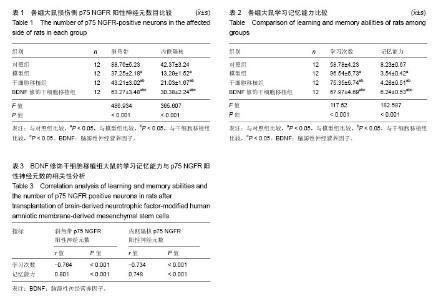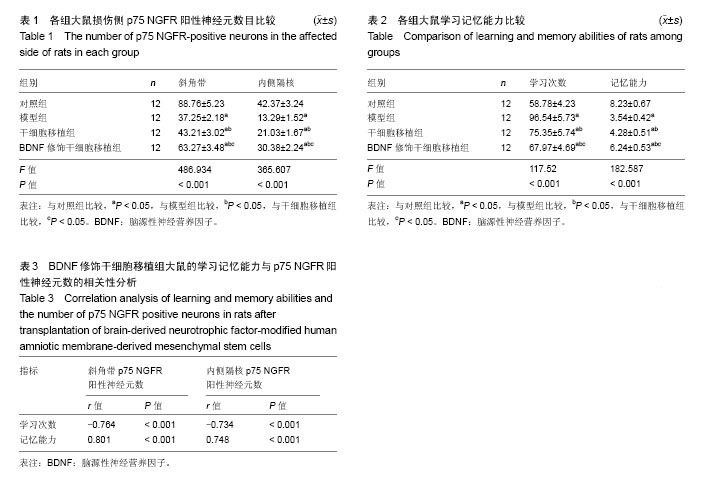Chinese Journal of Tissue Engineering Research ›› 2018, Vol. 22 ›› Issue (9): 1419-1424.doi: 10.3969/j.issn.2095-4344.0474
Previous Articles Next Articles
Effects of brain-derived neurotrophic factor-modified human amniotic membrane-derived mesenchymal stem cell transplantation on learning and memory abilities of Alzheimer's disease rats
Gao Ming-long1, Shi Shao-xia1, Zhang Kun1, Zhang Ying-dong1, Li Na1, Yu Ming1, Wang Yong-liang1, 2
- 1Department of Psychiatry, First Affiliated Hospital of Hebei Medical University, Shijiazhuang 050031, Hebei Province, China; 2Hebei Provincial Institute of Mental Health/ Hebei Provincial Key Laboratory of Aging and Cognitive Psychology, Shijiazhuang 050031, Hebei Province, China
-
Revised:2018-01-19Online:2018-03-28Published:2018-04-03 -
Contact:Wang Yong-liang, Master, Attending physician, Department of Psychiatry, First Affiliated Hospital of Hebei Medical University, Shijiazhuang 050031, Hebei Province, China; Hebei Provincial Institute of Mental Health/Hebei Provincial Key Laboratory of Aging and Cognitive Psychology, Shijiazhuang 050031, Hebei Province, China -
About author:Gao Ming-long, Master, Attending physician, Department of Psychiatry, First Affiliated Hospital of Hebei Medical University, Shijiazhuang 050031, Hebei Province, China -
Supported by:the Scientific Research Project of Hebei Provincial Health Department, No. ZL20140099; the project funded by the Hebei Provincial Health Department, No. 20130578
CLC Number:
Cite this article
Gao Ming-long, Shi Shao-xia, Zhang Kun, Zhang Ying-dong, Li Na, Yu Ming, Wang Yong-liang. Effects of brain-derived neurotrophic factor-modified human amniotic membrane-derived mesenchymal stem cell transplantation on learning and memory abilities of Alzheimer's disease rats[J]. Chinese Journal of Tissue Engineering Research, 2018, 22(9): 1419-1424.
share this article

2.1 人羊膜间充质干细胞的形态 培养12 h开始少量贴壁生长;培养24 h贴壁生长细胞增多(图1A);培养72 h时贴壁细胞明显增多,细胞呈三角形、放射状或短梭状生长(图1B);培养7 d细胞呈纺锤形或梭形成纤维细胞样生长,形成细胞克隆集落(图1C)。原代培养12 d贴壁细胞长满瓶底,呈长梭形、形态均一,漩涡状排列,达85%融合,经消化后进行传代。传代培养24 h细胞呈长梭形、完全贴壁生长;传代培养72 h细胞呈漩涡样排列,融合达80%以上;传代培养7 d细胞完全融合(图1D),继续再次传代培养。 2.2 流式细胞仪检测人羊膜间充质干细胞表面标记 第3代人羊膜间充质干细胞表面高表达CD44、CD29、CD105、CD90分子,阴性表达CD34、CD31和CD45分子。 2.3 各组大鼠p75 NGFR阳性神经元数目比较 各组大鼠斜角带和内侧隔核p75 NGFR阳性神经元数比较差异有显著性意义(P < 0.05),其中模型组、干细胞移植组、BDNF修饰干细胞移植组斜角带和内侧隔核p75 NGFR阳性神经元数均低于对照组(P < 0.05),干细胞移植组、BDNF修饰干细胞移植组斜角带和内侧隔核p75 NGFR阳性神经元数均高于模型组(P < 0.05),BDNF修饰干细胞移植组斜角带和内侧隔核p75 NGFR阳性神经元数高于干细胞移植组 (P < 0.05)。见表1,图2,3。 2.4 各组大鼠学习记忆能力比较 各组大鼠的学习记忆能力比较差异有显著性意义(P < 0.05),其中模型组、干细胞移植组、BDNF修饰干细胞移植组大鼠的学习记忆能力均低于对照组(P < 0.05),干细胞移植组、BDNF修饰干细胞移植组大鼠的学习记忆能力均高于模型组(P < 0.05),BDNF修饰干细胞移植组大鼠的学习记忆能力高于干细胞移植组(P < 0.05)。见表2。 2.5 BDNF修饰干细胞移植组大鼠的学习记忆能力与p75 NGFR阳性神经元数的相关性分析 BDNF修饰干细胞移植组大鼠的学习次数与p75 NGFR阳性神经元数呈负相关(P < 0.05),记忆能力与p75 NGFR阳性神经元数呈正相关(P < 0.05)。见表3。"

| [1] Alonso R, Pisa D, Marina AI, et al. Fungal infection in patients with Alzheimer's disease. J Alzheimers Dis. 2014;41(1): 301-311. [2] Haapasalo A, Pikkarainen M, Soininen H. Alzheimer's disease: a report from the 7th Kuopio Alzheimer symposium. Neurodegener Dis Manag. 2015;5(5):379-382.[3] Han JW, Choi D, Lee MY, et al. Bone Marrow-Derived Mesenchymal Stem Cells Improve Diabetic Neuropathy by Direct Modulation of Both Angiogenesis and Myelination in Peripheral Nerves. Cell Transplant. 2016;25(2):313-326.[4] 梁维,刘洲,许志恩,等.细胞传代对骨髓间充质干细胞向神经干细胞分化的影响[J].中国组织工程研究,2016,20(41):6092-6097.[5] 王思淼,刘丽萍,王晓斐,等.骨髓间充质干细胞移植对老年痴呆大鼠的防治作用[J].中国老年学杂志,2012,32(13):2792-2794.[6] Zheng XY, Wan QQ, Zheng CY, et al. Amniotic Mesenchymal Stem Cells Decrease Aβ Deposition and Improve Memory in APP/PS1 Transgenic Mice. Neurochem Res. 2017;42(8): 2191-2207.[7] 丛姗,宋瑾,张惠娟,等.人羊膜间充质干细胞(hAMSCs)的分离、体外培养及诱导分化[J].农业生物技术学报,2015,23(1):20-31.[8] 钟慧霖,陈文明,李翠莹,等.移植BDNF和GDNF基因修饰的hMSCs对大鼠大脑中动脉阻塞的影响[J].中国病理生理杂志, 2014,30(1):102-109.[9] Yuan Y, Pan S, Sun Z, et al. Brain-derived neurotrophic factor-modified umbilical cord mesenchymal stem cell transplantation improves neurological deficits in rats with traumatic brain injury. Int J Neurosci. 2014;124(7):524-531.[10] Ibáñez CF, Simi A. p75 neurotrophin receptor signaling in nervous system injury and degeneration: paradox and opportunity. Trends Neurosci. 2012;35(7):431-440.[11] Chen T, Yu Y, Tang LJ, et al.Neural stem cells over-expressing brain-derived neurotrophic factor promote neuronal survival and cytoskeletal protein expression in traumatic brain injury sites.Neural Regen Res. 2017;12(3): 433-439.[12] Scheltens P, Blennow K, Breteler MM, et al. Alzheimer's disease. Lancet. 2016;388(10043):505-517.[13] Heo JS, Choi Y, Kim HS, et al. Comparison of molecular profiles of human mesenchymal stem cells derived from bone marrow, umbilical cord blood, placenta and adipose tissue. Int J Mol Med. 2016;37(1):115-125. [14] 于宁,王彦生,齐常萍,等.碱性成纤维细胞生长因子基因转染骨髓间充质干细胞在失神经肌肉萎缩中的应用[J].中国组织工程研究, 2016,20(1):89-94.[15] Salem AM, Ahmed HH, Atta HM, et al. Potential of bone marrow mesenchymal stem cells in management of Alzheimer's disease in female rats. Cell Biol Int. 2014;38(12): 1367-1383.[16] 谷玉静,刘敬禹.BMSCs移植改善老年性痴呆大鼠空间记忆能力的实验研究[J].临床医学工程,2013,20(3):285-287.[17] Bae JS, Jin HK, Lee JK, et al. Bone marrow-derived mesenchymal stem cells contribute to the reduction of amyloid-β deposits and the improvement of synaptic transmission in a mouse model of pre-dementia Alzheimer's disease. Curr Alzheimer Res. 2013;10(5):524-531.[18] Drela K, Lech W, Figiel-Dabrowska A, et al. Enhanced neuro-therapeutic potential of Wharton's Jelly-derived mesenchymal stem cells in comparison with bone marrow mesenchymal stem cells culture. Cytotherapy. 2016;18(4): 497-509. [19] 苏立宁,宋小青,魏会平,等.神经生长因子诱导大鼠骨髓间充质干细胞向神经细胞分化的效果观察及相关蛋白网络分析[J].山东医药,2016,56(39):33-35.[20] Xie J, Xiao D, Xu Y, et al. Up-regulation of immunomodulatory effects of mouse bone-marrow derived mesenchymal stem cells by tetrahydrocannabinol pre-treatment involving cannabinoid receptor CB2. Oncotarget. 2016;7(6):6436-6447.[21] 杨军政,李永海,李萌,等.脐带血间充质干细胞向神经细胞诱导分化及应用[J].重庆医学,2014,43(3):366-368,369.[22] Ha CW, Park YB, Chung JY, et al. Cartilage Repair Using Composites of Human Umbilical Cord Blood-Derived Mesenchymal Stem Cells and Hyaluronic Acid Hydrogel in a Minipig Model. Stem Cells Transl Med. 2015;4(9):1044-1051. [23] 周晶晶,徐芳,俞明明,等.人脐带血间充质干细胞改善大鼠脑梗死免疫炎性反应的研究[J].中华老年心脑血管病杂志,2016,18(1): 81-84.[24] 马延,郭金耀,刘雷,等.GM1体外诱导人脐带血间充质干细胞分化为神经样细胞研究[J].标记免疫分析与临床, 2016,23(12): 1464-1467.[25] Li Y, Guo L, Ahn HS, et al. Amniotic mesenchymal stem cells display neurovascular tropism and aid in the recovery of injured peripheral nerves. J Cell Mol Med. 2014;18(6): 1028-1034.[26] 洪佳琼,高雅,宋洁,等.人羊膜间充质干细胞与骨髓间充质干细胞的生物学特性及免疫抑制作用的比较[J].中国实验血液学杂志, 2016,24(3):858-864.[27] Yu SC, Xu YY, Li Y, et al. Construction of tissue engineered skin with human amniotic mesenchymal stem cells and human amniotic epithelial cells. Eur Rev Med Pharmacol Sci. 2015;19(23):4627-4635.[28] 周文然,李新,王文波,等.人羊膜间充质干细胞生物学特征及向多巴胺能神经元样细胞的分化[J].中国组织工程研究,2014, 18(23): 3682-3690.[29] Dionigi B, Ahmed A, Brazzo J 3rd, et al. Partial or complete coverage of experimental spina bifida by simple intra-amniotic injection of concentrated amniotic mesenchymal stem cells. J Pediatr Surg. 2015;50(1):69-73.[30] 赵宇.尾静脉移植羊膜间充质干细胞对缺血再灌注损伤后神经功能恢复的影响[J].中国组织工程研究,2017,21(5):707-712.[31] Kim KS, Kim HS, Park JM, et al. Long-term immunomodulatory effect of amniotic stem cells in an Alzheimer's disease model. Neurobiol Aging. 2013;34(10): 2408-2420.[32] 陈勇,方宁,陈代雄,等.人羊膜间充质干细胞移植治疗帕金森病模型大鼠的疗效评价[J].中风与神经疾病杂志,2015,32(5): 406-410.[33] Jiao H, Shi K, Zhang W, et al. Therapeutic potential of human amniotic membrane-derived mesenchymal stem cells in APP transgenic mice. Oncol Lett. 2016;12(3):1877-1883.[34] Han ZM, Huang HM, Wang FF. Brain-derived neurotrophic factor gene-modified bone marrow mesenchymal stem cells. Exp Ther Med. 2015;9(2):519-522.[35] 任瑞芳,黄良国,黄名璐,等.BDNF对BMSCs向脑出血灶周围组织迁移的保护作用[J].中华神经医学杂志,2014,13(3):252-256.[36] Yuan Y, Pan S, Sun Z, et al. Brain-derived neurotrophic factor-modified umbilical cord mesenchymal stem cell transplantation improves neurological deficits in rats with traumatic brain injury. Int J Neurosci. 2014;124(7):524-531.[37] 尹良伟,王禹兹,陈涛,等.BDNF基因转染神经干细胞移植脑损伤大鼠移植细胞存活率和 Trkβ、Erk1/2、Ras及 Trx 的表达[J].大连医科大学学报,2016,38(5):422-427.[38] Bowling H, Bhattacharya A, Klann E,et al.Deconstructing brain-derived neurotrophic factor actions in adult brain circuits to bridge an existing informational gap in neuro-cell biology. Neural Regen Res. 2016;11(3):363-367. 1[39] Zhang X, Zhu J, Zhang K, et al. Over-expression of brain-derived neurotrophic factor in mesenchymal stem cells transfected with recombinant lentivirus BDNF gene. Cell Mol Biol (Noisy-le-grand). 2016;62(14):29-33. [40] 熊敏,何宁,曾云,等.脑源性神经营养因子基因修饰脂肪间充质干细胞治疗大鼠急性脊髓损伤[J].中华实验外科杂志, 2012,29(11): 2271-2273.[41] Lu H, Liu X, Zhang N, et al. Neuroprotective Effects of Brain-Derived Neurotrophic Factor and Noggin-Modified Bone Mesenchymal Stem Cells in Focal Cerebral Ischemia in Rats. J Stroke Cerebrovasc Dis. 2016;25(2):410-418. [42] Nonner D, Temple S, Barrett JN. Rat embryonic septal neurons survive and express cholinergic properties in isolation and without nerve growth factor. Brain Res Dev Brain Res. 1992;70(2):197-205.[43] Morse JK, Wiegand SJ, Anderson K, et al. Brain-derived neurotrophic factor (BDNF) prevents the degeneration of medial septal cholinergic neurons following fimbria transection. J Neurosci. 1993;13(10):4146-4156.[44] Alderson RF, Alterman AL, Barde YA, et al. Brain-derived neurotrophic factor increases survival and differentiated functions of rat septal cholinergic neurons in culture. Neuron. 1990;5(3):297-306. |
| [1] | Li Xuan, Sun Yimin, Li Longbiao, Wang Zhenming, Yang Jing, Wang Chenglin, Ye Ling. Manufacturing of nano-modified polycaprolactone microspheres and its biological effects in dental pulp cells [J]. Chinese Journal of Tissue Engineering Research, 2022, 26(10): 1602-1608. |
| [2] | Liu Xiaogang, Li Tian, Zhang Duo. Effect and mechanism of the effective components of Chinese medicine on promoting the differentiation of bone marrow mesenchymal stem cells into chondrocytes [J]. Chinese Journal of Tissue Engineering Research, 2022, 26(1): 121-126. |
| [3] | Yang Tengyun, Li Yanlin, Liu Dejian, Wang Guoliang, Zheng Zhujun. Chondrogenic differentiation of peripheral blood-derived mesenchymal stem cells induced by transforming growth factor beta 3: a dose-effect relationship [J]. Chinese Journal of Tissue Engineering Research, 2022, 26(1): 45-51. |
| [4] | Jing Jin, Zhao Shandi, Chen Long, Peng Shuanglin, Tang Hui, Guo Daijin, Zeng Xinyi, Xiao Jingang. Repair of calvarial defects in osteoporotic mice by adipose-derived stem cells combined with biphasic calcium phosphate ceramic scaffold [J]. Chinese Journal of Tissue Engineering Research, 2022, 26(1): 90-95. |
| [5] | Kang Yue, Liu Jie. Biological function of circular RNAs in osteogenic differentiation of mesenchymal stem cells [J]. Chinese Journal of Tissue Engineering Research, 2022, 26(1): 107-112. |
| [6] | Xie Xingqi, Hu Wei, Tu Guanjun. Bone marrow mesenchymal stem cells-derived exosomes combined with chondroitinase ABC for treating spinal cord injury in rats [J]. Chinese Journal of Tissue Engineering Research, 2022, 26(1): 20-26. |
| [7] | Lin Miaoyuan, Li Yuwan, Liu Yi, Chen Bei, Zhang Li. Research hotspots and application value of tissue-engineered skin [J]. Chinese Journal of Tissue Engineering Research, 2022, 26(1): 159-166. |
| [8] | Zhang Tongtong, Wang Zhonghua, Wen Jie, Song Yuxin, Liu Lin. Application of three-dimensional printing model in surgical resection and reconstruction of cervical tumor [J]. Chinese Journal of Tissue Engineering Research, 2021, 25(9): 1335-1339. |
| [9] | Zeng Yanhua, Hao Yanlei. In vitro culture and purification of Schwann cells: a systematic review [J]. Chinese Journal of Tissue Engineering Research, 2021, 25(7): 1135-1141. |
| [10] | Xu Dongzi, Zhang Ting, Ouyang Zhaolian. The global competitive situation of cardiac tissue engineering based on patent analysis [J]. Chinese Journal of Tissue Engineering Research, 2021, 25(5): 807-812. |
| [11] | Wu Zijian, Hu Zhaoduan, Xie Youqiong, Wang Feng, Li Jia, Li Bocun, Cai Guowei, Peng Rui. Three-dimensional printing technology and bone tissue engineering research: literature metrology and visual analysis of research hotspots [J]. Chinese Journal of Tissue Engineering Research, 2021, 25(4): 564-569. |
| [12] | Chang Wenliao, Zhao Jie, Sun Xiaoliang, Wang Kun, Wu Guofeng, Zhou Jian, Li Shuxiang, Sun Han. Material selection, theoretical design and biomimetic function of artificial periosteum [J]. Chinese Journal of Tissue Engineering Research, 2021, 25(4): 600-606. |
| [13] | Liu Fei, Cui Yutao, Liu He. Advantages and problems of local antibiotic delivery system in the treatment of osteomyelitis [J]. Chinese Journal of Tissue Engineering Research, 2021, 25(4): 614-620. |
| [14] | Li Xiaozhuang, Duan Hao, Wang Weizhou, Tang Zhihong, Wang Yanghao, He Fei. Application of bone tissue engineering materials in the treatment of bone defect diseases in vivo [J]. Chinese Journal of Tissue Engineering Research, 2021, 25(4): 626-631. |
| [15] | Zhang Zhenkun, Li Zhe, Li Ya, Wang Yingying, Wang Yaping, Zhou Xinkui, Ma Shanshan, Guan Fangxia. Application of alginate based hydrogels/dressings in wound healing: sustained, dynamic and sequential release [J]. Chinese Journal of Tissue Engineering Research, 2021, 25(4): 638-643. |
| Viewed | ||||||
|
Full text |
|
|||||
|
Abstract |
|
|||||

